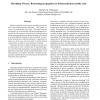Free Online Productivity Tools
i2Speak
i2Symbol
i2OCR
iTex2Img
iWeb2Print
iWeb2Shot
i2Type
iPdf2Split
iPdf2Merge
i2Bopomofo
i2Arabic
i2Style
i2Image
i2PDF
iLatex2Rtf
Sci2ools
ACSAC
2002
IEEE
2002
IEEE
Throttling Viruses: Restricting propagation to defeat malicious mobile code
Modern computer viruses spread incredibly quickly, far faster than human-mediated responses. This greatly increases the damage that they cause. This paper presents an approach to restricting this high speed propagation automatically. The approach is based on the observation that during virus propagation, an infected machine will connect to as many different machines as fast as possible. An uninfected machine has a different behaviour: connections are made at a lower rate, and are locally correlated (repeat connections to recently accessed machines are likely). This paper describes a simple technique to limit the rate of connections to “new” machines that is remarkably effective at both slowing and halting virus propagation without affecting normal traffic. Results of applying the filter to web browsing data are included. The paper concludes by suggesting an implementation and discussing the potential and limitations of this approach.
| Added | 14 Jul 2010 |
| Updated | 14 Jul 2010 |
| Type | Conference |
| Year | 2002 |
| Where | ACSAC |
| Authors | Matthew M. Williamson |
Comments (0)

